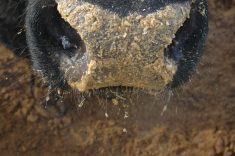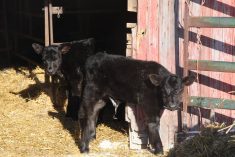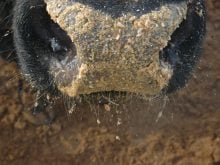Planting a variety of forage crops in the same field can be successful, but it’s important to watch for potential dangers
REGINA — Poly crops have become a popular way to feed cattle, but more research is needed into the nutritional properties of the plants in each blend.
Jennifer Hayden, a livestock and feed extension specialist from North Battleford, Sask., said poly crops can provide relief to pastures, especially during drought. They can be grazed, baled or put up as silage.
They may also provide improved feed quality because many are high in protein and energy and can produce a lot of biomass.
However, she said producers should be aware of what they plant and what actually grows.
Read Also

Quebec pork company calls for transparency around gene-edited pigs
Quebec-based pork company duBreton is calling for transparency around meats from gene-edited pigs on concerns that a lack of mandatory labelling will confuse consumers, and dilute certification claims. The organic sector is also calling for labelling rules.
Some poly crop mixes contain eight or more species.
“I think when we talk about composition, we have to remember that what we seed isn’t necessarily what we get in that field. There’s a difference between the percentage in the blend versus what actually grows in the field. Sometimes we just don’t have the right moisture or the temperatures to necessarily accommodate everything that was seeded,” she said during a webinar.
The forages in a poly crop fall into four categories: warm season crops such as corn, millet, sorghum, sorghum Sudan grass and sunflowers; cool season crops such as barley, oats, triticale and buckwheat; legumes like peas, fababeans, hairy vetch and soybeans; and brassicas including kale, radish, turnips and canola.
Hayden said some of the crops will have anti-nutritional properties.
“Don’t get me wrong. I think these poly crops, we have a lot of potential for really good nutritional quality. But I do think that we do have to be aware of some of the issues that can come up when we are using them,” she said.
For example, sulphur found in the brassica plants binds to trace minerals, namely copper, and leads to deficiencies. This can lead to polio, blindness and sometimes death.
If sulphur is high in the cattle’s drinking water, the problems can also add up.
Nitrates are typically thought to accumulate from stress events such as frost. However, drought and hail can have the same effect. Although most poly crops don’t require fertilization, some producers may still add nitrogen, which compounds the problem.
Typically, nitrates can be found in cereals, canola and some weeds.
“Some research has also shown that we end up with higher nitrates in warm season versus cool season crops,” said Hayden.
Potassium toxicity from legumes can interfere with the absorption of magnesium and calcium. Symptoms include a staggering gait, muscle tremors and cattle that are nervous and excitable.
Typically, this affects older cows, those close to calving and cows with calf at side.
“Our maximum tolerable level of potassium in the diet for cattle is around that two to 2.5 percent of dry matter,” said Hayden.
There is one key way to prevent any of these from happening: a feed test.
There are other issues that can arise from poly crops.
Crops such as canola, mustard, flax and sunflowers may not be palatable. If the plants go to seed and the seeds are ingested, there could be production of prussic or hydrocyanic acid that lead to asphyxiation.
Hayden said the concentrations in flax, sorghum and sorghum Sudan grass are highest in the leaves. Green flax in a blend could be a problem.
Livestock poisoned by prussic acid tend to die within minutes to a few hours.
She said testing for prussic acid is available, so anyone with these plants in a blend should do that to be sure.
Hairy vetch seeds contain cacogenic glycosides and can lead to asphyxiation.
Sweet clover in a mix doesn’t cause grazing issues but can if it is put up as hay or silage in a blend.
If the hay is damp or the silage is exposed to oxygen, the clover can become contaminated with mould. That mould can contain a toxin that acts as a blood thinner. Hayden said the amount of visible mould is not a good indicator of how much toxin is in that mould.
She added that atypical interstitial pneumonia, known as AIP or fog fever, is sometimes seen going into the fall, particularly when cattle are moved from a worn-out pasture into one with lush growth. This happens with any type of lush green forage, not just poly crops.
“We will often see animals that have trouble breathing. They’re sort of anxious or maybe they’re grunting. They often froth around the mouth. If you try to move them, they’re reluctant to walk,” she said.
Cattle should be full when moved into that new feed source, similar to moving onto an alfalfa forage.
Producers could provide additional low quality forage, offered free choice, so the animals can move between the two sources.
Hayden added producers should also consider the protein-to-fibre ratio in poly crops. They generally contain a lot of protein but may be provided at a time when the cows’ requirements are lower and it gets lost out the back end.
Other concerns with poly crops are preferential grazing and dry matter. Often the mixes are high moisture, which can limit intake.


















